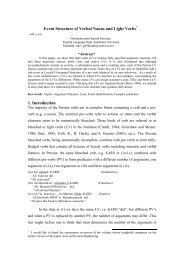Separability of Light Verb Constructions in Persian*
Separability of Light Verb Constructions in Persian*
Separability of Light Verb Constructions in Persian*
Create successful ePaper yourself
Turn your PDF publications into a flip-book with our unique Google optimized e-Paper software.
Neither can the LV itself predicate the clause nor is there any semantically transparent<br />
argument bear<strong>in</strong>g DP or N to complete its defective or bleached a-structure.<br />
5. Conclusion<br />
LVCs as compound units, function<strong>in</strong>g as s<strong>in</strong>gle predicates, are different from<br />
simple lexical verbs because the simple verbs, unlike LVCs (1-5 or 31-33), cannot be<br />
broken and separated. However, the <strong>in</strong>separability <strong>of</strong> cases like (32-33) could mislead<br />
some to believe that the <strong>in</strong>ternal structure <strong>of</strong> some LVCs is not visible to the syntax and<br />
the LVCs are lexical items identical to simple verbs. It has been clarified that the<br />
<strong>in</strong>separability <strong>of</strong> LVCs is because <strong>of</strong> the semantic and morphosyntactic properties <strong>of</strong> PVs<br />
and LVs, so it cannot be because <strong>of</strong> the fact that separable and <strong>in</strong>separable LVCs are<br />
formed at two different levels <strong>of</strong> representation.<br />
The role <strong>of</strong> LVs and PVs <strong>in</strong> LVCs or clauses, especially the dual role <strong>of</strong> PVs as a<br />
part <strong>of</strong> a predicate and at the same time as a case marked specific DP argument is a<br />
complicated issue. Although researchers do not agree on the exact role <strong>of</strong> LVs and PVs,<br />
<strong>in</strong> Karimi-Doostan (2005) PVs contribute the thematic roles or a-structure <strong>of</strong> LVCs while<br />
LVs at least carry verbal features and may assign accusative case. Case mark<strong>in</strong>g ability <strong>of</strong><br />
the LVs is not semantically restricted. This means that the LVs may case mark DPs<br />
which are not the arguments <strong>of</strong> the LVs. In Megerdooma<strong>in</strong> (2001; 2002) and Folly,<br />
Harley and Karimi (2005), the <strong>in</strong>ternal arguments are contributed by the PVs and they<br />
may be case marked as direct objects. Obviously, they receive their case from the LVs.<br />
When the LVs can case mark the arguments <strong>of</strong> PVs we should expect them to be able to<br />
case mark the DP PVs too, provided that the PV is predicative (36). On the contrary, <strong>in</strong><br />
the <strong>in</strong>separable LVCs (18a, 18c, 32-33), the PVs cannot be augmented <strong>in</strong>to DP and<br />
cannot receive accusative case from the LVs because they do not satisfy the requirements<br />
<strong>in</strong> (36).<br />
Reference:<br />
Abney, S. (1987) The English Noun Phrase <strong>in</strong> its Sentential Aspects. Ph.D. Dissertation,<br />
Cambridge: MIT.<br />
Ahn, H. (1990) 'On light verb construction <strong>in</strong> Korean and Japanese,' In Hajime Hoji<br />
27



